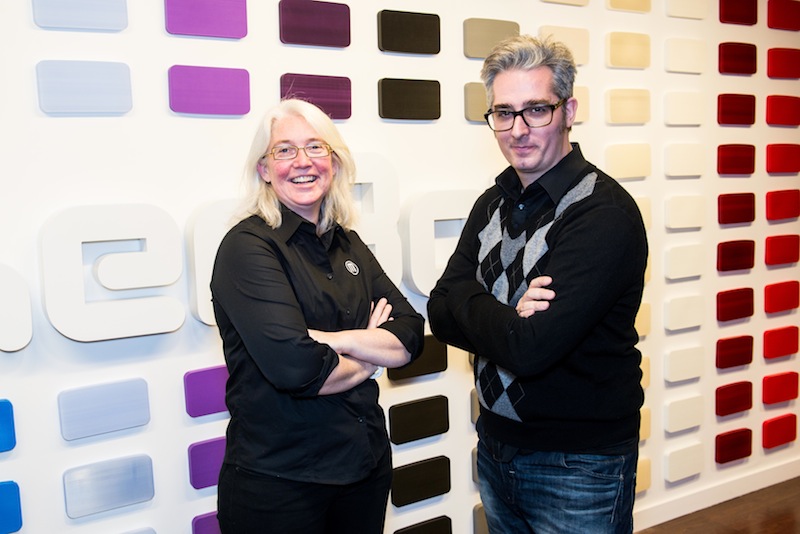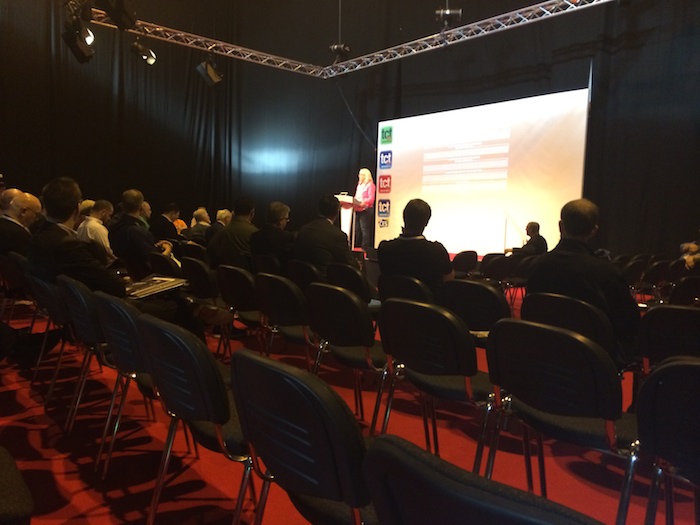Top of my personal highlights at the TCT Show last week was getting to hear Jenny Lawton speak. As I mentioned in my review of the show, I had met her previously — and briefly — when she was President of MakerBot. Now though, she’s rolling up her sleeves and taking on the more hands-on role of CEO, since the co-founder and previous CEO — one Bre Pettis — took a step back from MakerBot.
Originally they were both supposed to be attending the TCT Show together to deliver the keynote address, but following the news breaking about the MakerBot boardroom reshuffle sooner than was originally intended, Jenny took to the stage alone, while Bre remained in the States, focused on his new project.
I’ve never made a secret of the fact that I like Bre — when he’s on form, he is infectious, and love him or loathe him (there are lots on both sides these days) anyone would be silly to deny that he had a great deal to do with putting 3D printing on the map. I got the feeling when the news broke a few weeks back that he was exhausted and that to get back to his best, he needed to get back to his creative roots, and boardrooms do not really suit his personality. Jenny kind of confirmed this to me later, and also confirmed she was supposed to talk more about it all during her presentation but it didn’t quite pan out that way and we (the conference audience) got some great, and very insightful, perspective on MakerBot instead — hers!
I have rarely heard such an obviously unpracticed yet self-assured speech. Sagacious in delivery it was without distracting slides, and it was compelling. For me personally, it gave me an injection of motivation that was much needed.
Not least because Jenny’s history is a varied — and inspiring — one. Her background is one of start-ups and entrepreneurialism — she gave lots of examples and was totally unashamed to say that she “fell into this new innovation cycle,” as she recalled the first time she met Bre and saw a 3D printer having walked into the “BotCave” – “it changed my life and the way I thought about things.” One of the core things that she has come to love about MakerBot — as a product and as a culture — is that it challenges how she thinks, how we should all think, about how things are made. How do we make things? How could we make things? Indeed, how should we make things?
Taking a step (or few) back from MakerBot however, Jenny gave us insight into her background. With searing honesty we heard about her success with SaaS start-up’s through the 90’s, and her personal transitional moment that came for her on 9/11 when she dropped out of the traditional workforce to set up a couple of independent bookshops and a café in Greenwich, CT. Or as she put it, she decided to “get off the bus for a bit.” Living so close to the city and having been personally affected by the September 11th horrors in 2001, this could have easily turned into a self-serving story. It didn’t. Pragmatism featured more than emotion. I can not identify with what happened in NYC in 2001, but in terms of getting off the bus, I did, and I couldn’t have been more grateful, on that day, to hear a confident, successful and really very likeable woman just saying it as it was. During the following decade, it turned out that independent retail was one of the hardest things Jenny had undertaken in her life, a time during which she learned a great deal. Not least how important customers are and more vitally still — listening to them. In 2011, however, having run out of money, Jenny decided to “re-enter the workforce.” Then she learned a whole lot more working with a range of companies developing medical devices and solar installations and such. But she was aware that she really wanted something completely new. It was at this time that a long time friend and mentor set up a meeting for her with Bre Pettis.
Having never been to Brooklyn before, she found herself crossing the Brooklyn Bridge for the first time ever wondering what lay ahead. At this time she met the Bre Pettis that was “out to change the world” and he was different from anyone she had ever met before. And the 3D printers he showed her were different from anything she had ever seen before. This was 2011 and MakerBot had been going for two years since it was founded in 2009 by Bre along with his then partners Adam Mayer and Zach Smith and now the company employed 40 people. Jenny was keenly aware that MakerBot needed to grow and grow fast and this involved innovation cycles, new products, solutions (product and corporate) and disruptions by doing things differently. It seems Bre didn’t quite see it that way at the time and they went their separate ways.
And while Jenny didn’t quite say it in so many words last week, what was very obvious to me was from that very first meeting she had caught the 3D printing bug. She may not have understood the nuts and bolts of it but she “got” it and she knew her input could make a difference for this start-up. Her most telling statement, to me at least, was when she said: “I kept bugging Bre. I knew he needed help.”
For better or worse, women are good at that — intuition and bugging men that don’t know when to ask for help. It paid off — for both of them and they agreed to meet for lunch. It seems that Bre didn’t think MakerBot could afford Jenny’s services, and ever one to leap over hurdles, Jenny told him: “don’t be stupid make me an offer. And it has to include a 3D printer!”
Needless to say he did. And the rest, as they say, is history.
Bre’s passion, which Jenny recounts he had in spades, together with amazing vision and her understanding of start-ups and entrepreneurialism have seen the company grow from 40 personnel to 600 personnel in the three years she has been there.
“These are the days” she said, and repeated a few sentences later. Indeed they are. But that is because 3D printing is STILL underdeveloped, she says, citing the hardware, the software, and the entire ecosystem. But she did keep coming back to the software (lots of people did last week).
“Each piece of the puzzle is here,” she said. The point being that we may have all the pieces but we have not fitted them all together yet. And this is not all about MakerBot either. Jenny was quick to credit the large number and wide variety of other companies all working in this space: “all trying to be part of the industrial revolution – and all of them are necessary for growth, all have potential.”
She’s not totally up herself either, and that was probably her most endearing quality. She is more than aware that there is love and hate out there for MakerBot and she relishes that — “I love that there are people that criticise us, this is how the ecosystem will grow.”
But she is quite rightly rather proud of the growth that her expertise has facilitated, which can be seen in the successful expansion programme across three NYC locations, but most aptly summed up with the delivery of this line: “We have a FACTORY in Brooklyn NY. And it’s awesome — It still blows my mind!” There is a downside to this phenomenal growth, however, and that, she says, is that she no longer knows everyone’s name. However, even so, it’s still fairly easy to recognize a MakerBot employee in all of their facilities, apparently, as they are still the only ones that tend to wear jeans and turn up to work with their skateboards.
The growth also involved a much bigger management team, processes and procedures and identifying and portraying the MakerBot brand. The latter of these is hard to dispute, this they did well — and visibly. Central to this were the core MakerBot values, their customers, their customers’ needs and providing a product to meet them. Then, Jenny said it was about “iterat[ing] the hell out of it – even if people are frustrated at first. Hear what they need and make the product better.”
And, she is listening, because she said: “There is LOTS to listen to.”
Personally I think the MakerBot brand was central to the Stratasys acquisition, and Jenny did not gloss over this, although at first I thought she might, when she said “Along the way we also got acquired by Stratasys.” A lot of ears pricked up at that point, would she go into detail?
This is Jenny Lawton we’re talking about, of course she would.
Unsurprisingly, the most common question when it comes to the Stratasys deal is “WHY??”
She doesn’t duck that — she obviously gets on well with Scott Crump, likes him a lot it seems, with lots of complimentary adjectives thrown around. But when it comes to the business side of things she has tunnel vision and it all comes down to “What are you going to do when you grow up?” For MakerBot, at that time it was about raising funding to fulfil the vision …. and potentially going public. Thus when Stratasys originally offered a “business development relationship” she pre-empted the power play and talked about acquisition as a way for MakerBot to go public faster than they otherwise would, at full pelt, but in the safest way possible.
The deal breaker though was that MakerBot would always be black and red — never orange and blue. And that seems to be the case, still.
Of course there were compromises — there has to be for anyone building a responsible business, and she knows better than most that start-ups suffer a much higher failure rate than success rate. But here she used an interesting analogy “We sprint at times but we have to be in it for the long haul — and run a marathon.”
Jenny is also a big fan of competition and, more poignantly, being friendly with competitors, and “not in a ‘keeping your enemies close’ kinda way either.” Her philosophy on this is “You don’t have to like me but I would really like you to respect me!”
In this way, respect can generate new partnerships: “Who can I work with and how – a printer is just a printer – and that’s where the ecosystem comes into play – and partnerships.”
Couldn’t agree more and I know a few people that could do with learning that particular lesson! Why? Well, Jenny covered that too: “Sometimes it feels like it’s a knife fight – but it’s not.”
No, it’s not, it’s just 3D printing.
By now I felt like I was listening to a kindred spirit, to be honest, particularly when she summed up: “I can’t wait for the whole evolution with the CAD companies – not just 3D models but 3D printable models. It will be years until that happens – 10/15/20 more years until we come out of the early adopters phase. It will move faster but not as fast as most people think.”





